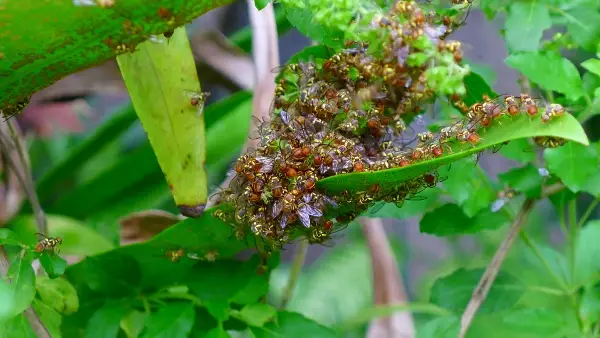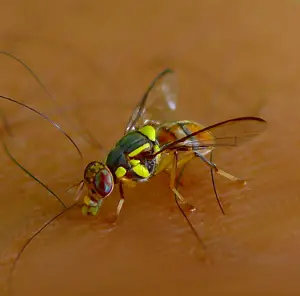Why do bees swarm in one place, usually a plant? Here is my little bee story of a recent experience and some facts about bee stings.
One morning, I noticed something unusual is happening in our garden. There seems to be a clump of insects flying about in one of the breast high potted plants in the lawn just beneath a stunted coconut tree. I cautiously approached what I suspected to be a swarm of wild bees … and indeed, it is.
Instinctively, I hurried up back inside the house to get my camera. A few seconds later, I’m back ready to take shots of a rare event.
Thinking I am at a safe distance away from the wild bees and mindful that I might disturb them and get bitten, I gradually approached the swarm and held my breath. This approach seemed to work in my past encounters with wild bees. Besides, I am confident that they will not sting unless they are threatened or harmed. My bee culture experience for the past several years also helped.
I aimed my camera and got the picture below showing bees clumped together on the leaves of a fern next to the plant where the other bees alighted.

I wondered why these bees stayed on the leaves when no flower is in sight where they could gather their usual supply of nectar to be stored in their honeycombs. What could be the reason for their stay there?
I searched the internet and found out that these gathering of bees must be transient in nature. I’ve read an article that says these honeybees are on the move to find their new home. And this could be true because after the day I saw the swarm of bees, they are gone the next day.

At left is a picture of a bee that curiously landed on my skin. It didn’t prick me with its rear end sting but just stayed there. I held my breath once again and took a close-up shot. Had I swatted this bee, I might be inviting other bees to come because of its alarm pheromone. Crushing the bee will alarm the other bees and invite disaster.
According to Dylan Voeller and James Nieh of the University of California San Diego, honeybees are stimulated to attack once the alarm pheromone is released. This can be made worse if the victim wears dark clothes, releases carbon dioxide and moves jerkily. If this is assumed to be an evolutionary behavior, the response increases the survival of the colony as predators are warded off the hive. However, honeybees die once they let go of their sting. Once their sting got stuck on the skin of their victim, they are emboweled once they fly away. Further, the bee distracts the victim by flying about (as if intending to sting) for awhile until it finally dies.
So holding my breath and wearing light clothes would have worked. No bee from the swarm stung me at all. If they did, I will hose them out with water to drive them away.
Any interesting bee story you can share?
© 2014 August 11 P. A. Regoniel


